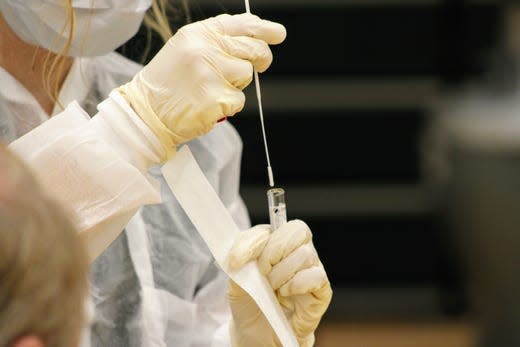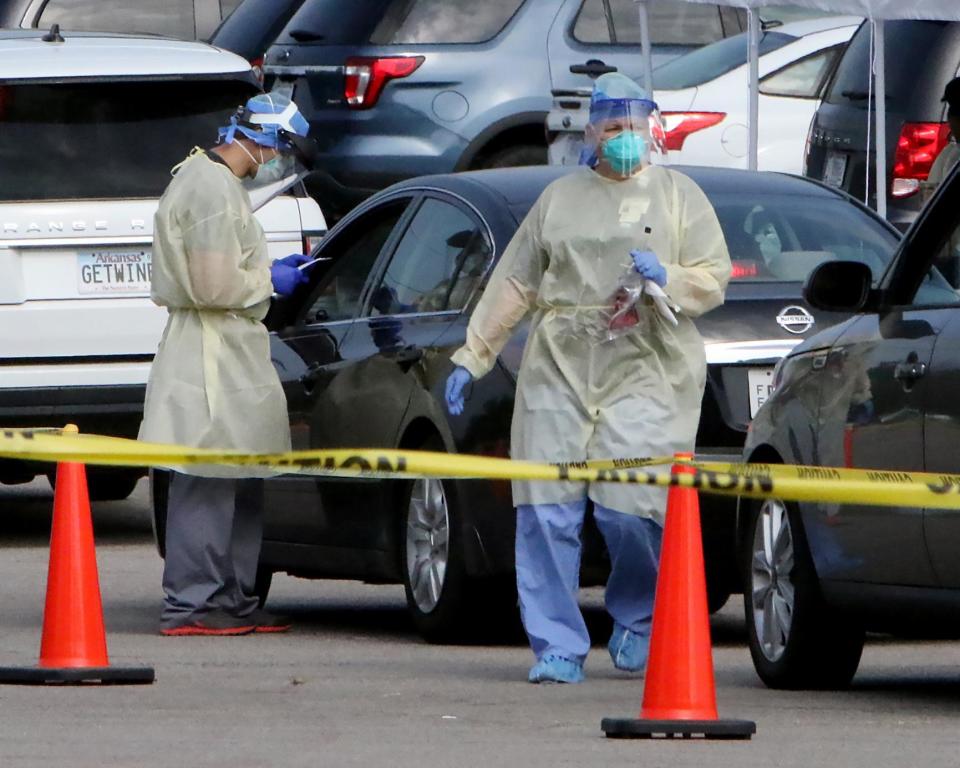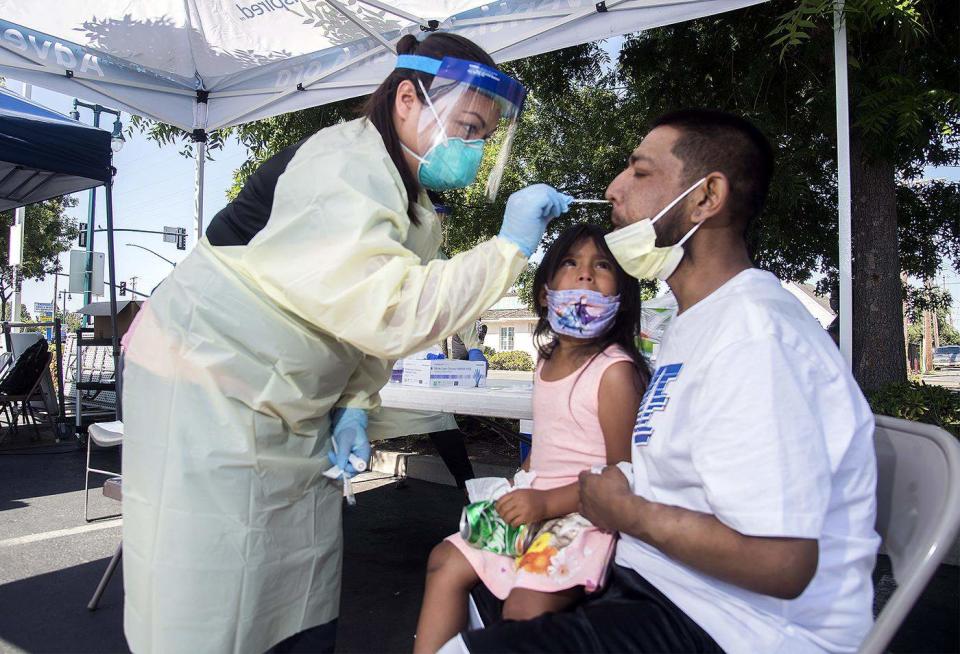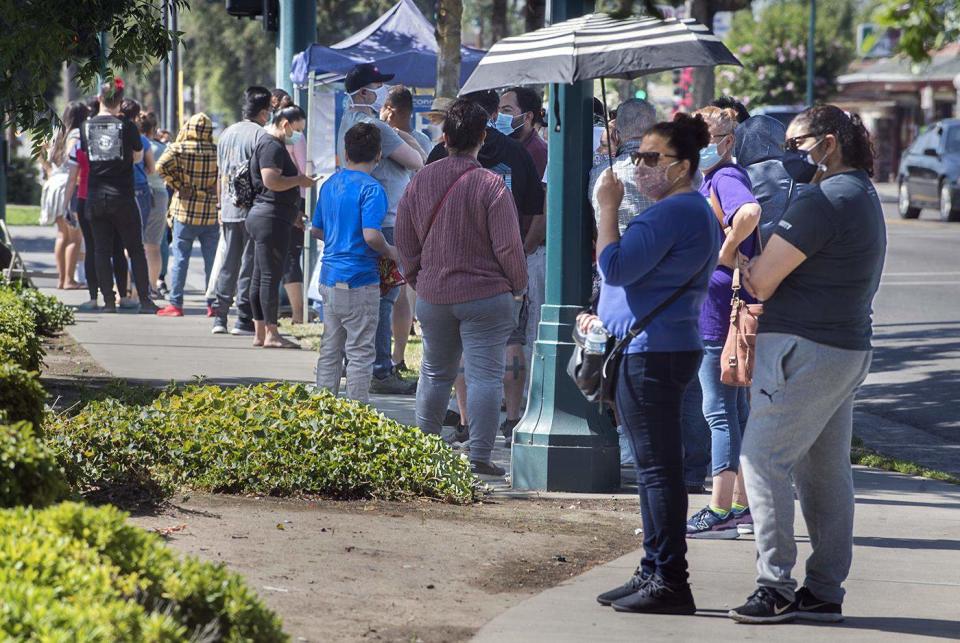Leaders were slow to bring COVID-19 testing to Latino communities. Now people are sick.
It was mid-June in California's Central Valley, and Dr. Patricia Iris was alarmed.
Every COVID-19 patient at Lodi Memorial that day was Latino, even though Latinos make up only 39% of the city’s population.
More: Leer en español
Testing surveillance in San Joaquin County should have warned Iris that this was coming. But testing in Latino communities was so limited, it missed the oncoming wave.
Hospital beds swelled with Latino patients. On June 1, the county had just 23 patients hospitalized with COVID-19. By the end of the month, there were 140. Most, according to Iris, were Latino.
The numbers continue to rise. As of July 20, hospitals in the county were operating their ICUs at 132% capacity.
“People are on waiting lists to get tested,” said San Joaquin County Public Health Officer Dr. Maggie Park. “It’s not a good situation at all.”
The same dynamic has played out across the nation as the virus silently spread among Latinos from workplaces to homes to the community. Latinos bore the brunt of the virus. And, experts and advocates say, inadequate testing is one of the reasons.

In 20 of 27 states that reported positive coronavirus cases by ethnicity, growth among Latinos has outpaced overall growth since Memorial Day, according to a USA TODAY analysis. Nationwide, Latinos have been four times as likely as whites to be hospitalized, according to data from the U.S. Centers for Disease Control and Prevention.
Although few states or counties publish the ethnicity of people being tested, available data show one key disparity. The World Health Organization says if more than 5% of tests in one community come back positive, it’s a sign testing isn’t widespread enough to find and isolate infectious people, including those without symptoms.
In some places where the non-Latino positivity rate fell below 5%, Latino rates remained in double digits – three times as high or more.
USA TODAY has reported that Latinos’ disproportionate role in meatpacking and other hard-hit industries contributed to outbreaks in some towns. But as the experience in Lodi and other places show, government agencies failed to adequately distribute testing or educational resources to Latino communities.

Limited testing meant local officials couldn’t intervene or offer support services designed to slow the spread and minimize the economic harm of isolating.
In San Joaquin County, the first free walk-up testing site opened in May was a two-hour bus ride for Latinos living in the city of Tracy, for example, or a 36-mile drive for anyone with a car. Arkansas had a single Spanish-speaking caseworker for two counties with large populations of Latinos, one-third of whom speak limited English. An Omaha health center serving low-income Latinos said more than half of its coronavirus tests in April came back positive; Nebraska did not open a new testing site in that neighborhood for weeks, despite local pleas.
Experts say it all added up to needless delays and fewer Latinos being tested. It meant infectious people kept working instead of isolating, which led to more infections. It meant they were disconnected from community resources designed to reduce the virus’ spread. It meant they were left at home with family members rather than being safely quarantined at a hotel.
By the time local and state leaders realized what they were facing, outbreaks were already well past the point of control.
Testing patients as soon as symptoms start can reduce transmission rates by 80%. Delaying three days reduces transmission by only 21%, according to a study in The Lancet Public Health, a medical journal.
“Our priorities for testing do not reflect the needs in our communities,” said Dr. Nirav Shah, a scholar at Stanford University's Clinical Excellence Research Center. “They have prioritized what has been easy to do: add additional capacity to the existing health care system. That system already had access problems for marginalized communities.”
Latino leaders across the country said public officials haven’t listened to their concerns – and then have been caught off guard when the coronavirus cut through their families exactly as predicted.
At the Catholic Charities Diocese of Stockton in San Joaquin County, Executive Director Elvira Ramirez says she noticed a lack of testing as early as March.
“Every time we would ask, ‘Well what about testing?’ it seemed as though there was no testing being done,” Ramirez said. “Finally there is something in place, but it seems woefully inadequate to the need.”
Failings in Arkansas
Jackie Tobias, of Northwest Arkansas, said that when she lost her sense of smell and taste, she worried that she had contracted the coronavirus.
Just a couple of days earlier, the Latina human resources professional had visited her parents. They work at an area poultry processing plant, a high-exposure environment linked to outbreaks nationwide.
“Maybe my mom was asymptomatic and I’ve been exposed,” she remembers thinking.
Her primary care doctor had an opening in two days, longer than she wanted to wait. Screeners at the door to a local safety-net clinic told her she needed an appointment – a detail not mentioned on the clinic’s website – and it would be a few days to fit her in. The county health department had no openings and referred her back to the clinic she had visited.

Finally, after looking for help in three towns, she was swabbed at an urgent care clinic 35 minutes away.
The staff told her results would not be back for at least a week.
When her parents sought testing, they were told that without symptoms they could be tested only if Tobias’ results came back positive. Without test results, they continued to work.
“If it takes me seven days to get my results before they can get tested and then seven days for them to get their results,” Tobias thought to herself. “Someone could die before they could even get tested or get their results back.”
Her mother later developed symptoms that qualified her to be tested. The test came back positive.
Officials in Arkansas were slow to recognize outbreaks among Latinos and their barriers to testing.
Its increase in Latino cases over the past two months was the biggest out of 27 states that report cases by ethnicity. Cases among Arkansas Latinos grew five times as fast as cases in the overall population, a USA TODAY analysis found.
On June 10, Arkansas officials asked the CDC for help investigating outbreaks in the state’s Hispanic and Marshallese communities, groups that dominate the workforce in poultry plants. By then, COVID-19 had moved beyond mere workplace spread, according to the CDC’s report on the outbreaks. It was spreading in households, at community events, in grocery stores and in shared transport on the way to work.
Later that same month, the state worked to expand testing access for Hispanic and Marshallese residents.
“The outbreak became very obvious once the testing became free and many, many more individuals were tested,” said Dr. Jose Romero, interim health secretary for Arkansas.
This month, the CDC submitted a 59-page report finding that Arkansas failed to prioritize testing in high-risk environments like meatpacking plants and in multigenerational households, said CDC epidemiologist Angela Hernandez.

Hernandez’ team also urged Arkansas leaders to focus prevention, support services and testing in Hispanic and Marshallese communities.
“Rapid control of the spread of COVID-19 will help minimize illness, deaths and the social and economic impact,” Hernandez wrote in an email to USA TODAY and the Midwest Center for Investigative Reporting.
On Friday, Arkansas legislators voted to delay hearing a request from the state health department to spend $7 million of federal funds to expand testing and contact tracing in Latino and Marshallese communities, according to the Arkansas Democrat Gazette.
A key coronavirus benchmark
Across the country, it is difficult to quantify the gaps in testing between Latinos and other ethnic groups because the data isn’t public, if it’s collected at all. Only six states disclose the race and ethnicity of people tested, and the data is spotty. Indiana recorded race and ethnicity in less than half of all tests.
But one measure that is available in a handful of locations highlights the gap in Latino testing that experts have warned about.
In places where it was available by ethnicity, the percentage of Latinos testing positive was usually much higher than the World Health Organization’s benchmark of 5%, by wide margins, even when the target was met for non-Latinos.
“It basically says that there's disparities about how often testing is available in these communities,” said Dr. Ali Khan, who became dean of the College of Public Health at the University of Nebraska Medical Center after leading preparedness efforts at the CDC.
In Illinois, the positivity rate for non-Latinos dipped as low as 3% in late June, according to the state’s website. Yet among Latinos, the rate remained around 10% to 15% during the same period.

Outside Austin, Texas, in the town of Pflugerville, non-Latinos had a 4% positivity rate compared with 29% for Latinos, a local health center reported in May.
Samples collected from 35 health facilities in the Baltimore and Washington, D.C., metropolitan area showed white non-Latino whites tested positive a little under 5% of the time in late May, yet the Latino rate was around 35%.
Decades of budget cuts to public health programs left county and state officials across the country ill-prepared to respond to every challenge that a pandemic presents. Testing was no exception.
“Nationally, people didn’t recognize the importance of public health,” said Park, the San Joaquin County health officer. “Nobody realized what a health officer was until COVID hit.”
From the outset, Park understood that inequities in the health care system and in the economy put Latinos at unique risk. She knew that some Latinos have less access to social services because of language barriers and fears that using public programs would bar them from seeking citizenship.
And, because the federal pandemic stimulus bills excluded noncitizens and mixed-immigration-status households, Park suspected some Latinos would feel pressure to work despite the risk.

About half of San Joaquin County’s 48,000 uninsured residents are noncitizens, according to census estimates, and most are Latinos. About a quarter of the county’s 267,000 Latino residents report they do not speak English well.
But Park wasn’t able to launch a radio and billboard messaging campaign in Spanish until July.
“The truth is, I just got permission to use the funds,” she said.
Federal funding from the federal CARES Act did not reach the county until May 12. By then, Latinos accounted for half of area cases. Park said it took weeks more to design an outreach plan and get it approved.
Similar bureaucratic and practical barriers plagued efforts to launch accessible testing sites.
The county’s first free testing site opened April 8 with supplies from the state, in a parking lot near San Joaquin General Hospital south of Stockton.
The site was drive-up only. According to Census figures, as many as half of households in some Latino neighborhoods of San Joaquin County do not own a vehicle.
In May, the state paid for a second free site that could serve people without a car but set physical requirements for the building and dictated the ZIP code where it must be located. Lodi Public Library was the only place that met the state’s specifications.
A resident of Tracy without a car would have to take a two-hour bus ride to get to the testing site for an appointment. As of Saturday, the soonest available appointment was in five days.
Jose Santoyo, 23, a Lodi native who works as an electrician and has insurance, decided to get tested after coming into contact with two people who had tested positive.
His mother told him about a free, pop-up testing site in a grocery store parking lot. Santoyo, whose test came back negative, became one of the 300 people tested that day after waiting about a half-hour in line. More than 200 other people were turned away when organizers ran out of tests.
“If I didn’t go to that place, I don’t know where I would have gone,” Santoyo said.
Experts said demand often outpaces capacity at free sites, creating delays people with insurance don’t face when tested by the family doctor.
“When we talk about equity, we’re not just talking about access. We’re talking about equity in the quality of care, too,” said Dr. Kathleen Page, who started the Johns Hopkins Organization for Latino Awareness and runs a community testing program in marginalized communities of Baltimore.
Nationally, people in areas with larger minority populations had to travel farther to get to COVID-19 testing sites, a May study in the Journal of Travel Medicine found.
Most testing is done by private companies, which receive $100 in reimbursements for each test they perform.
Shah, the Stanford researcher, said testing companies have no financial incentive to target supplies where they are needed most, to offer hours that meet the scheduling needs of essential workers, or to return results quickly.
The more tests, the more money – regardless of who’s tested.
Missed opportunities
Racial and ethnic disparities in the pandemic are slowly gaining additional scrutiny.
Last month, the U.S. Department of Health and Human Services issued guidelines making labs report race and ethnicity for all coronavirus tests. The rules take effect on Saturday, more than three months after the federal CARES Act required such reporting.

Health experts said equal access to coronavirus testing should have been a focus from the start – even before data confirmed Latinos were at increased risk to become ill and die.
“Data will lag behind the community wisdom,” said Page, the doctor and public health equity expert from Johns Hopkins. “What we could’ve built if those Latino community leaders had been heard before, in addition to capacity, is trust.”
Jose Rodriguez, president of the Central Valley California nonprofit El Concilio, agreed. While he appreciates that area hospitals and health departments have worked with his organization in recent weeks, he wishes that their programs were accessible and equitable by original design.
“Every time there’s an outbreak, they come to us rather than ... taking our needs into account while planning,” said Jose Rodriguez, president of the nonprofit social services organization El Concilio in California’s Central Valley.
As Page set up a free testing site at a Baltimore church last week, she said making health care and social services more accessible would help the entire community. Without improvements, she said, Latinos will continue to receive less testing and more might delay care.
“Just last week a man died at home because he didn’t know where to go,” she said. “The family said he was worried about the medical bill. That’s really unfortunate and could’ve been prevented.”
Jayme Fraser is an investigative reporter with USA TODAY.
This article originally appeared on USA TODAY: COVID testing: Latinos see more cases due to inadequate outreach, data


